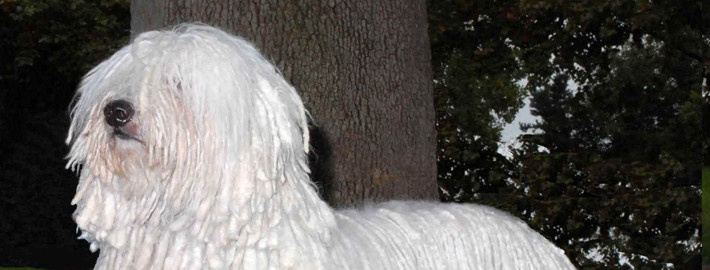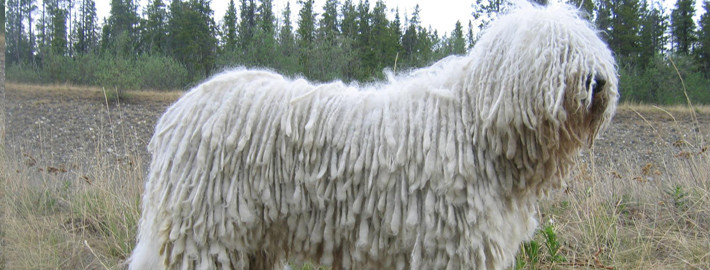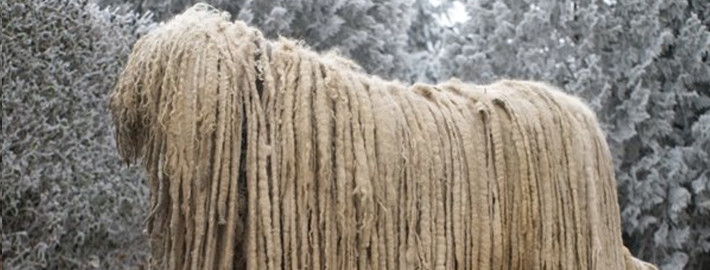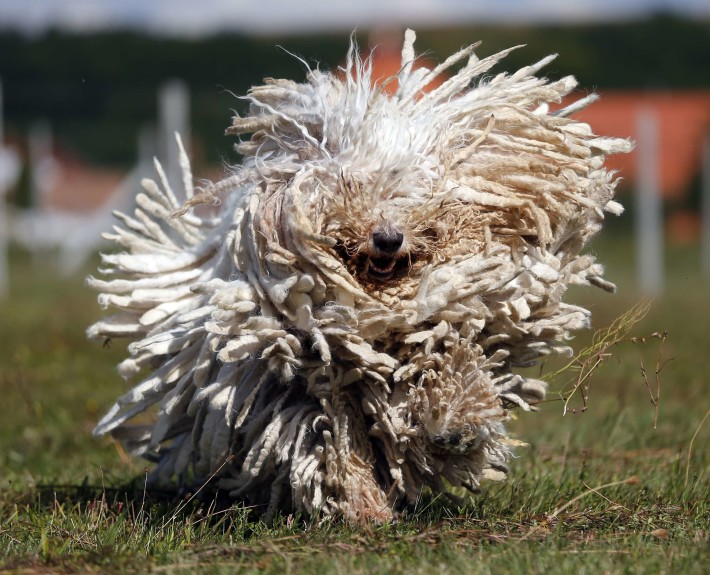What makes the Komondor Unique?
Although they may resemble giant dust mops that happen to be alive, members of this guardian breed have been successfully looking after livestock in their homeland since the Middle Ages.
Breed Groups
Page Contents
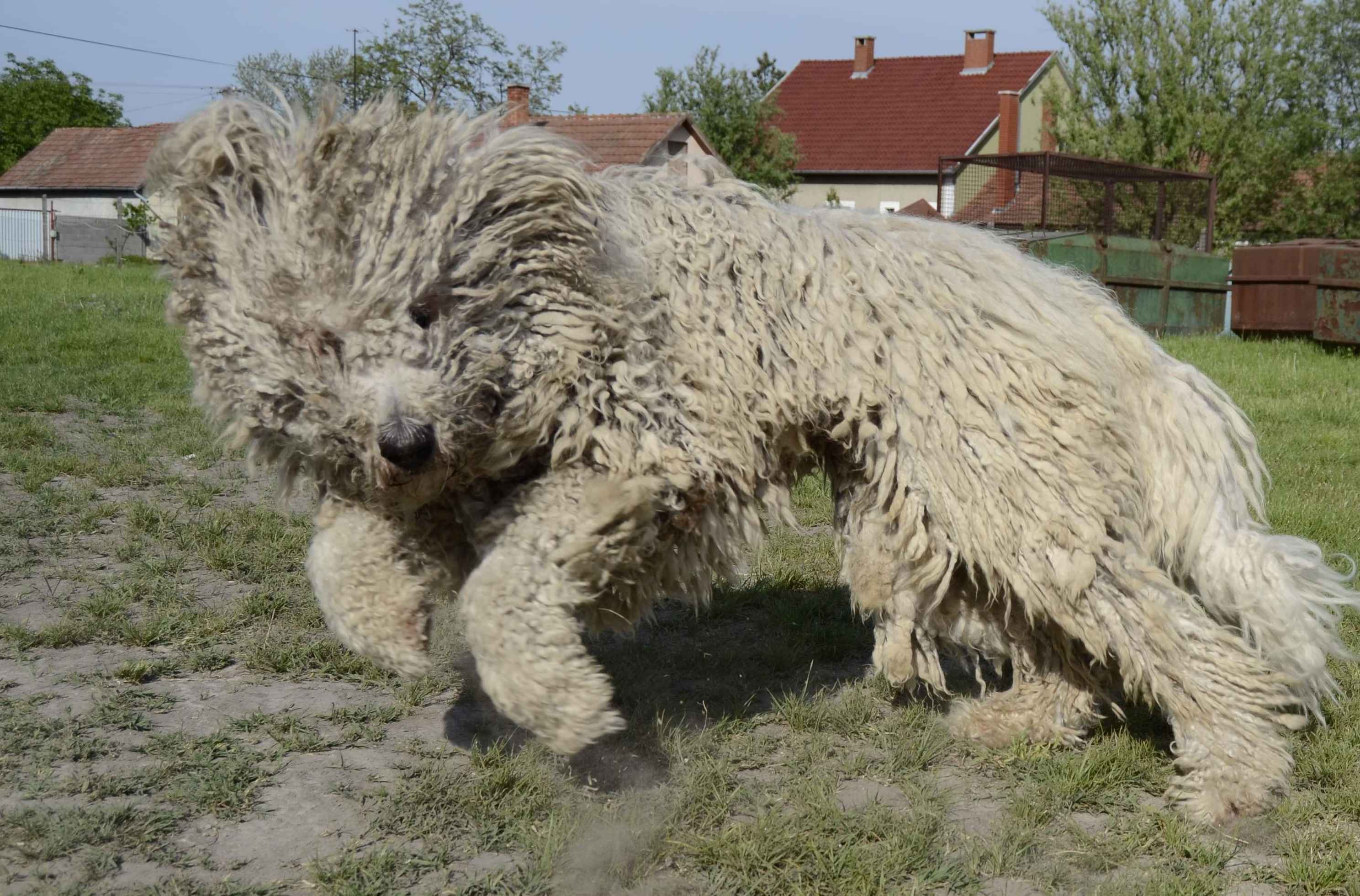
Is the Komondor Right For You?
Komondor dogs are well-known for their placid, dignified dispositions. However, members of this breed are very affectionate towards members of their own family. Unlike some breeds, these dogs typically regard children, other pets, and livestock as their personal responsibility and they will go to any lengths to protect the aforementioned individuals from coming to harm. These dogs are fearless in the face of danger. Training is nonetheless important for members of this breed. After all, a Komondor who doesn’t know the difference between a child that is playing with their friends and one that is being attacked may attempt to intervene under erroneous assumptions.
In 5 Words
- Steady
- Calm
- Affectionate
- Gentle
- Fearless
Characteristics
Learn About the Komondor
Description
General Description
Komondor dogs are large animals with athletic bodies. They are somewhat longer than they are tall. Members of this breed possess sizeable heads, square-shaped muzzles, and black noses. Their teeth should meet in a scissors bite. These dogs typically have brown, almond-shaped eyes that are of a medium size. Komondors also have triangular ears with rounded tips. Long, slightly curved tails are yet another feature of this breed and these appendages are generally carried at a downwards angle. The dogs’ sturdy legs and sizeable feet are particularly useful in helping them travel quickly.
Size
Size is an important requirement for members of this breed. Female dogs should stand no less than 25.5 inches (65 centimeters) in height and male Komondors should stand at least 27.5 inches (70 centimeters) tall. Typically males of this breed weigh between 110 and 132 pounds (50 and 60 kilograms). Female dogs are somewhat smaller, with an average weight of about 88 to 100 pounds (40 to 50 kilograms).
Coat
These dogs have a thick, double coats that help protect them from harsh weather conditions and predatory animals that are intent on attacking their flocks. The coarse outer layer of their fur is wavy or curly in texture while the inner layer is thick and wooly. The two layers mat together and form cords that resemble dreadlocks when a Komondor reaches several years old. All members of this breed have white coats but some dogs may have fur that is more cream or tan colored than pure white. This is especially true of working animals that are not regularly washed.
Short History of the Komondor
It is generally believed that the ancestors of the modern Komondor breed were brought to Hungary by a nomadic people called the Cumans that settled in the region during the Dark Ages. Although there have been large sheepdogs in the country for many centuries, documents dating back to the 16th century are the first recorded mention of the Komondor breed. In 1937, these dogs were officially recognized by the American Kennel Club (AKC).
The Second World War had negative effect on the Hungarian dog population as breeding ceased and the existing specimens were decimated. There is even a local tale which mentions that in order to capture a farm or home, the invading armies would have to kill the Komondor dogs residing there first. Needless to say, the breed’s numbers were very low once peace was declared. During the 15 years after the war ended, only a thousand dogs were registered with various breed organizations. Due to help from the AKC and American breed enthusiasts, the Komondor numbers were fortunately brought back to stable level by the 1980s.
Temperament
Komondor dogs are well-known for their placid, dignified dispositions. However, members of this breed are very affectionate towards members of their own family. Unlike some breeds, these dogs typically regard children, other pets, and livestock as their personal responsibility and they will go to any lengths to protect the aforementioned individuals from coming to harm. These dogs are fearless in the face of danger. Training is nonetheless important for members of this breed. After all, a Komondor who doesn’t know the difference between a child that is playing with their friends and one that is being attacked may attempt to intervene under erroneous assumptions. Even so, these dogs are usually reserved rather than hostile around unfamiliar people. The same cannot be said of strange animals because Komondors are likely to attack them if they feel their territory has been invaded.
Caring for Your Komondor
General Health
Komondors are particularly susceptible to health problems like hip dysplasia and bloat. Giving your dog several small meals rather than one large one is a good way to avoid the latter condition. Some individuals may also have problems with allergies as well as ear and eye issues. Owners should note that Komondors tend to be lazy when they are not working and will quickly gain weight if they are overfed or not properly exercised.
Care
Daily
These dogs need to be walked two or three times per day if they are not looking after livestock. Komondors will also benefit daily obedience training to keep them on top of things.
Weekly
It is a good idea for pet owners to brush their dog’s teeth on a regular basis so that the individual in question does not fall prey to otherwise avoidable illnesses.
Monthly
Parasite prevention is highly recommended for all breeds of dogs. In order to obtain effective results, these products will usually need to be applied once per month.
Grooming & Bathing
Although they have remarkably thick coats, these dogs only shed modest amounts of fur. Prospective owners should nonetheless be aware that members of this breed do have extensive grooming requirements. Due to the fact that their fur naturally forms mats, these dogs cannot be combed or brushed. Instead, they must have their fur professionally trimmed. Of course, prospective owners can learn how to perform this procedure themselves from Komondor breeders or other individuals with professional dog grooming experience.
Regular baths are also a must for members of this breed but the dogs may take some time to dry out afterwards. It may be a good idea to use a hairdryer and several towels to help dry out your dog once they’ve been washed. Pet owners will also want to clean out their dog’s ears and trim their dog’s nails every so often to keep their Komondor looking its’ best.

